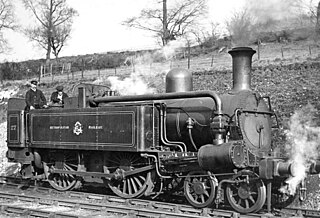The London, Midland and Scottish Railway had the largest stock of steam locomotives of any of the 'Big Four' Grouping, i.e. pre-Nationalisation railway companies in the UK. Despite early troubles arising from factions within the new company, the LMS went on to build some very successful designs; many lasted until the end of steam traction on British Railways in 1968. For an explanation of numbering and classification, see British Rail locomotive and multiple unit numbering and classification.
The Southern Railway took a key role in expanding the 660 V DC third rail electrified network begun by the London & South Western Railway. As a result of this, and its smaller operating area, its steam locomotive stock was the smallest of the 'Big Four' companies.
The London and North Eastern Railway (LNER) produced several classes of locomotive, mostly to the designs of Nigel Gresley, characterised by a three-cylinder layout with a parallel boiler and round-topped firebox. It produced the most famous locomotive of its day, 4468 'Mallard', the holder of the world steam locomotive speed record. It also built the world-famous 4472 'Flying Scotsman'. However, its locomotive inheritance was much greater than just the 'A4 Class', it also produced highly successful mixed-traffic and freight designs.

The North British Locomotive Company was created in 1903 through the merger of three Glasgow locomotive manufacturing companies; Sharp, Stewart and Company, Neilson, Reid and Company and Dübs and Company, creating the largest locomotive manufacturing company in Europe and the British Empire.
Beyer, Peacock and Company was an English railway locomotive manufacturer with a factory in Openshaw, Manchester. Founded by Charles Beyer, Richard Peacock and Henry Robertson, it traded from 1854 until 1966. The company exported locomotives, and machine tools to service them, throughout the world.

The Metropolitan Railway E Class is a class of 0-4-4T steam locomotives. A total of seven locomotives were built between 1896 and 1901 for the Metropolitan Railway: three by the railway at their Neasden Works and four by Hawthorn Leslie and Company in Newcastle upon Tyne.
The Metropolitan Railway G Class consisted of four 0-6-4T steam locomotives, numbered 94 to 97. They were built by Yorkshire Engine Company in 1915. The class was unusual in carrying names as well as numbers, and were the last Metropolitan steam locomotives to do so.
The Metropolitan Railway H Class consisted of eight 4-4-4T steam locomotives, numbered 103 to 110. They were built by Kerr, Stuart & Co of Stoke on Trent in 1920 at a cost of £11,575 each. A "notable addition" to the Metropolitan Railway, these locomotives were purchased for the express passenger trains on the mainline between Harrow —the change point from electric locomotives—and Aylesbury or Verney Junction.

The Metropolitan Railway K Class consisted of six 2-6-4T steam locomotives, numbered 111 to 116.

A condensing steam locomotive is a type of locomotive designed to recover exhaust steam, either in order to improve range between taking on boiler water, or to reduce emission of steam inside enclosed spaces. The apparatus takes the exhaust steam that would normally be used to produce a draft for the firebox, and routes it through a heat exchanger, into the boiler water tanks. Installations vary depending on the purpose, design and the type of locomotive to which it is fitted. It differs from the usual closed cycle condensing steam engine, in that the function of the condenser is primarily either to recover water, or to avoid excessive emissions to the atmosphere, rather than maintaining a vacuum to improve both efficiency and power.

The Metropolitan Railway A Class and B Class were 4-4-0T condensing steam locomotives built for the Metropolitan Railway by Beyer Peacock, first used in 1864. A total of 40 A Class and 26 of the slightly different B Class were delivered by 1885. Used underground, the locomotives condensed their steam, and coke or smokeless coal was burnt to reduce the smoke.
The Metropolitan Railway D Class was a group of six 2-4-0T locomotives built for the Metropolitan Railway in 1894-1895 by Sharp, Stewart and Company.

The LNER Class Y10 was a class of two 0-4-0T geared steam locomotives built by Sentinel Waggon Works for the London and North Eastern Railway and introduced in 1930. The LNER numbered them 8403 and 8404 but they were later re-numbered 8186 and 8187. This was the second use of the classification Y10 by the LNER. The first was for an ex-North British Railway 0-4-0 steam tender locomotive, withdrawn 1925.

The South African Railways Class 8E 4-8-0 of 1903 was a steam locomotive from the pre-Union era in the Cape of Good Hope.

The South African Railways Class 6C 4-6-0 of 1896 was a steam locomotive from the pre-Union era in the Orange Free State.
The South African Railways Class 6E 4-6-0 of 1898 was a steam locomotive from the pre-Union era in the Orange Free State.
District Railway steam locomotives were used on London's Metropolitan District Railway. When in 1871 the railway needed its own locomotives, they ordered twenty four condensing steam locomotives from Beyer Peacock similar to the A Class locomotives the Metropolitan Railway was using on the route. As they were intended for an underground railway, the locomotives did not have cabs, but had a weatherboard with a bent-back top and the back plate of the bunker was raised to provide protection when running bunker first.
London's Metropolitan Railway (MR) amalgamated with other underground railways, tramway companies and bus operators on 1 July 1933, to form the London Passenger Transport Board (LPTB); the MR became the Board's Metropolitan line.
The SER Q class was a class of 0-4-4T steam locomotives of the South Eastern Railway. The class was designed by James Stirling and introduced in 1881.

The first Metropolitan Railway steam locomotives were ordered in 1864 for the Metropolitan Railway, to replace the Great Western Railway locomotive that had opened their first line the previous year. A total of 116 locomotives were built, of which two survive in preservation.








